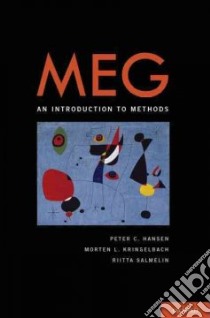Meg - 9780195307238
Un libro in lingua di Hansen Peter C. (EDT) Kringelbach Morten L. (EDT) Salmelin Riitta (EDT) edito da Oxford University Press, 2010
- € 79.40
- Il prezzo è variabile in funzione del cambio della valuta d’origine
"In combination with EEG and MR-based cortical reconstruction, MEG has considerably improved in the past ten years to become very close to the brain imager's long-awaited ideal---a non-invasive method capable of reconstructing human brain activity in both time and space. In this impressive volume, suitable for both beginners as well as advanced users, MEG methodology is reviewed in great depth, from the instrument itself to the reconstruction algorithms and some of their applications in various fields of cognitive neuroscience. Any neuroscientist who wishes to use this underexploited brain-imaging method (or simply to better understand the power and limitations of published MEG papers) should study this book---clearly a landmark in the field."---Stanislas Dehaene, College de France and INSERM-CEA
"Users of the increasingly popular technique of magnetoencephalography will welcome this excellent introductory guide to non-invasive imaging of the dynamics of the brain. The clear, tutorial style plugs a major gap in the literature of MEG by providing a comprehensive overview of theory, data acquisition and analysis using state-of-the-art techniques. Clinicians and scientists will find this to be a useful reference text."---Gary Green, York Neuroimaging Centre
"An essential reference for MEG researchers and a crucial resource for cognitive neuroscientists and clinians contemplating MEG experiments or evaluating the MEG literature. Expert, comprehensive and deep, this volume fills a long-recognized void. The book clearly and convincingly answers the question, `Why MEG?' as well as providing the best how-to-MEG manual currently available."---Alec Marantz, New York University
"The capability of MEG to combine the temporal resolution of electrophysiology with reasonable spatial localization power is extremely useful---but not sufficiently appreciated. The ambitious goal of this first rate collection of how-to articles on MEG experimentation is to provide readers with the necessary background and expertise to understand the underpinnings of MEG and execute a state-of-the-art study. The aim is admirably met; one wishes this book had existed for the last ten years! Undoubtedly, the volume will facilitate the increased use of the method in basic and clinical settings and be the definitive guide to using MEG across research areas."---David Poeppel, New York University
"An outstanding introduction to the science of magnetoencephalography (MEG), written by some of the world's experts. This book provides a competent overview of this expanding field of neuroimageing, which is the best by far in terms of temporal resolution. Some chapters also describe approaches combining MEG with other imaging techniques such as MRI, PET, or EEG, which may be the future."---Josef P. Rauschecker, Georgetown University Medical Center
Magnetoencephalography (MEG) is an exciting brain imaging technology that allows real-time tracking of neural activity, making it an invaluable tool for advancing our understanding of brain function. In this comprehensive introduction to MEG, Peter Hansen, Morten Kringelbach, and Riitta Salmelin have brought together the leading researchers to provide the basic tools for planning and executing MEG experiments, as well as analyzing and interpreting the resulting data. Chapters on the basic describe the fundamentals of MEG and its instrumentation, and provide guidelines for designing experiments and performing successful measurements. Chapters on data analysis present it in detail, from general concepts and assumptions to analysis of evoked responses and oscillatory background activity. Chapters on solutions propose potential solutions to the inverse problem using techniques such as minimum norm estimates, spatial filters and beamformers. Chapters on combinations elucidate how MEG can be used to complement other neuroimaging techniques. Chapters on applications provide practical examples of how to use MEG to study sensory processing and cognitive tasks, and how MEG can be used in a clinical setting. These chapters form a complete basic reference source for those interested in exploring or already using MEG that will hopefully inspire them to try developing new, exciting approaches to designing and analyzing their own studies. This book will be a valuable reference for researchers from diverse fields, including neuroimaging, cognitive neuroscience, medical imaging, and computer modeling, as well as for clinical practitioners.
Informazioni bibliografiche
- Titolo del Libro in lingua: Meg
- Sottotitolo: An Introduction to Methods
- Lingua: English
- Autori : Hansen Peter C. (EDT) Kringelbach Morten L. (EDT) Salmelin Riitta (EDT)
- Editore: Oxford University Press
- Collana: Oxford Univ Pr (Hardcover)
- Data di Pubblicazione: 21 Giugno '10
- Genere: MEDICAL
- Argomenti : Magnetoencephalography Magnetoencephalography methods Nervous System Diseases diagnosis
- Pagine: 436
- ISBN-10: 0195307232
- EAN-13: 9780195307238


